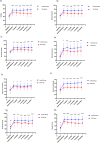Clinical study of short-term spinal cord stimulation for herpes zoster-associated pain
- PMID: 39702473
- PMCID: PMC11657820
- DOI: 10.1186/s40001-024-02196-6
Clinical study of short-term spinal cord stimulation for herpes zoster-associated pain
Abstract
Background: Zoster-associated neuralgia refers to neuropathic pain from herpes zoster, which can persist as postherpetic neuralgia (PHN). Preventing the progression to chronic PHN is crucial, yet optimal interventions is still not clear.
Objectives: This study evaluates the efficacy of short-term spinal cord stimulation (tSCS) in patients with subacute and chronic PHN.
Methods: A clinical study involved 135 patients with herpes zoster-associated pain (HZAP), divided into two groups: Experimental group which received short-term spinal cord stimulation therapy, and Control group which received conventional medical treatment and nerve block therapy. Pain intensity, sleep quality, anxiety and depression and quality of life were assessed at baseline and at 2 weeks, 1-, 3-, 6-, and 12-month post-treatment. Univariate and multivariate analyses identified factors associated with treatment efficacy.
Results: At 1-month follow-up, the experimental group showed significantly higher efficacy in pain reduction (P < 0.01). Higher Pittsburgh Sleep Quality Index (β = 0.093, P = 0.004) and PHQ-9 scores (β = 0.065, P = 0.031) before treatment were associated with better outcomes. At 3 months, longer disease duration (β = 0.103, P = 0.008) and higher Pittsburgh Sleep Quality Index scores (β = 0.114, P = 0.002) correlated with better efficacy, while higher Patient Health Questionnaire-9 scores were negatively correlated (β = - 0.023, P = 0.036). Although as follow-up time increases, the significant superiority of efficacy gradually shrinks compared with nerve block therapy at 6-12 months, the tSCS group still had better effects in improving sleep quality, anxiety and depression symptoms, and quality of life.
Conclusions: Short-term spinal cord stimulation is a safe and effective short-term treatment for HZAP, offering faster and more effective pain relief and quality of life improvement compared to nerve block therapy. However, there are challenges in maintaining the long-term effects of tSCS. Further studies with larger samples are needed to confirm these findings.
Keywords: Herpes zoster; Neuromodulation; Short-term spinal cord stimulation.
© 2024. The Author(s).
Conflict of interest statement
Declarations. Ethics approval and consent to participate: Ethical approval for this study was obtained from the Human Ethics Committee of The First Affiliated Hospital of Chongqing Medical University (K2023-200). Patient privacy and confidentiality were strictly maintained throughout the study by anonymizing personal identifiers. This study has ensured that all CARE guidelines and reports are fully conformed. Consent for publication: The patients were informed and we obtained written consent before writing this article. Competing interests: The authors declare no competing interests.
Figures
References
-
- Parkar S, Kegade P, Gade A, Sawant R. An overview of herpes zoster: Aetiology, pathogenesis and treatment.
-
- Park JM, Kim SE, Yang HC. Clinical characteristics of herpes zoster laryngitis. Eur Arch Otorhinolaryngol. 2020;277:2907–12. - PubMed
-
- Money S, Gharib M, Aiyer R. Post herpetic neuralgia: recent advancements. Curr Emerg Hosp Med Rep. 2020;8:45–9.
MeSH terms
LinkOut - more resources
Full Text Sources
Medical






